学术英语(人文)Unit 8
- 格式:ppt
- 大小:4.19 MB
- 文档页数:51
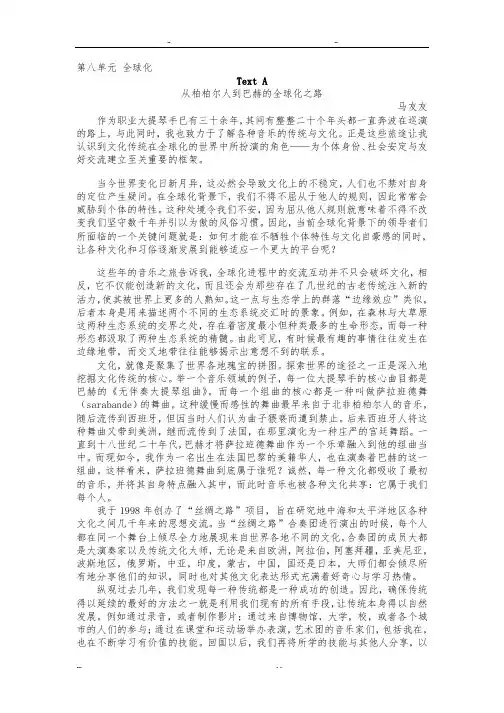
第八单元全球化Text A从柏柏尔人到巴赫的全球化之路马友友作为职业大提琴手已有三十余年,其间有整整二十个年头都一直奔波在巡演的路上,与此同时,我也致力于了解各种音乐的传统与文化。
正是这些旅途让我认识到文化传统在全球化的世界中所扮演的角色——为个体身份、社会安定与友好交流建立至关重要的框架。
当今世界变化日新月异,这必然会导致文化上的不稳定,人们也不禁对自身的定位产生疑问。
在全球化背景下,我们不得不屈从于他人的规则,因此常常会威胁到个体的特性。
这种处境令我们不安,因为屈从他人规则就意味着不得不改变我们坚守数千年并引以为傲的风俗习惯。
因此,当前全球化背景下的领导者们所面临的一个关键问题就是:如何才能在不牺牲个体特性与文化自豪感的同时,让各种文化和习俗逐渐发展到能够适应一个更大的平台呢?这些年的音乐之旅告诉我,全球化进程中的交流互动并不只会破坏文化,相反,它不仅能创造新的文化,而且还会为那些存在了几世纪的古老传统注入新的活力,使其被世界上更多的人熟知。
这一点与生态学上的群落“边缘效应”类似,后者本身是用来描述两个不同的生态系统交汇时的景象。
例如,在森林与大草原这两种生态系统的交界之处,存在着密度最小但种类最多的生命形态,而每一种形态都汲取了两种生态系统的精髓。
由此可见,有时候最有趣的事情往往发生在边缘地带,而交叉地带往往能够揭示出意想不到的联系。
文化,就像是聚集了世界各地瑰宝的拼图。
探索世界的途径之一正是深入地挖掘文化传统的核心。
举一个音乐领域的例子,每一位大提琴手的核心曲目都是巴赫的《无伴奏大提琴组曲》。
而每一个组曲的核心都是一种叫做萨拉班德舞(sarabande)的舞曲。
这种缓慢而感性的舞曲最早来自于北非柏柏尔人的音乐,随后流传到西班牙,但因当时人们认为曲子猥亵而遭到禁止。
后来西班牙人将这种舞曲又带到美洲,继而流传到了法国,在那里演化为一种庄严的宫廷舞蹈。
一直到十八世纪二十年代,巴赫才将萨拉班德舞曲作为一个乐章融入到他的组曲当中。
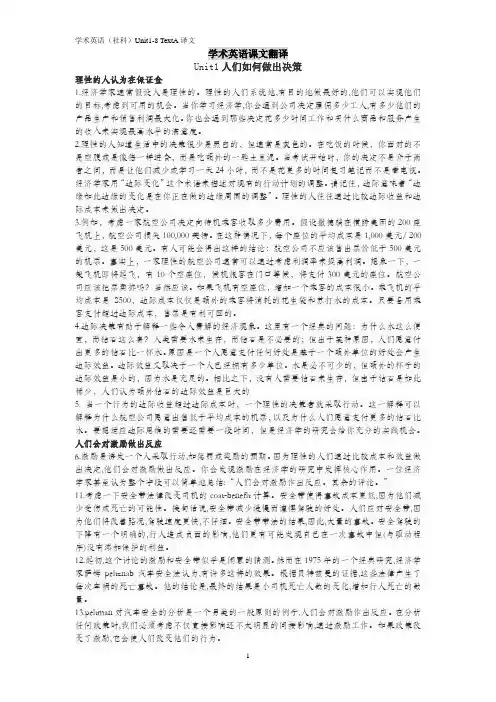
学术英语课文翻译Unit1人们如何做出决策理性的人认为在保证金1.经济学家通常假设人是理性的。
理性的人们系统地,有目的地做最好的,他们可以实现他们的目标,考虑到可用的机会。
当你学习经济学,你会遇到公司决定雇佣多少工人,有多少他们的产品生产和销售利润最大化。
你也会遇到那些决定花多少时间工作和买什么商品和服务产生的收入来实现最高水平的满意度。
2.理性的人知道生活中的决策很少是黑白的,但通常是灰色的。
在吃饭的时候,你面对的不是空腹或是像猪一样进食,而是吃额外的一匙土豆泥。
当考试开始时,你的决定不是介于两者之间,而是让他们减少或学习一天24小时,而不是花更多的时间复习笔记而不是看电视。
经济学家用“边际变化”这个术语来描述对现有的行动计划的调整。
请记住,边际意味着“边缘如此边缘的变化是在你正在做的边缘周围的调整”。
理性的人往往通过比较边际收益和边际成本来做出决定。
3.例如,考虑一家航空公司决定向待机乘客收取多少费用。
假设撒德躺在横跨美国的200座飞机上,航空公司损失100,000英镑。
在这种情况下,每个座位的平均成本是1,000美元/ 200美元,这是500美元。
有人可能会得出这样的结论:航空公司不应该售出票价低于500美元的机票。
事实上,一家理性的航空公司通常可以通过考虑利润率来提高利润。
想象一下,一架飞机即将起飞,有10个空座位,候机旅客在门口等候,将支付300美元的座位。
航空公司应该把票卖掉吗?当然应该。
如果飞机有空座位,增加一个乘客的成本很小。
乘飞机的平均成本是S500,边际成本仅仅是额外的乘客将消耗的花生袋和苏打水的成本。
只要备用乘客支付超过边际成本,售票是有利可图的。
4.边际决策有助于解释一些令人费解的经济现象。
这里有一个经典的问题:为什么水这么便宜,而钻石这么贵?人类需要水来生存,而钻石是不必要的;但出于某种原因,人们愿意付出更多的钻石比一杯水。
原因是一个人愿意支付任何好处是基于一个额外单位的好处会产生边际效益。
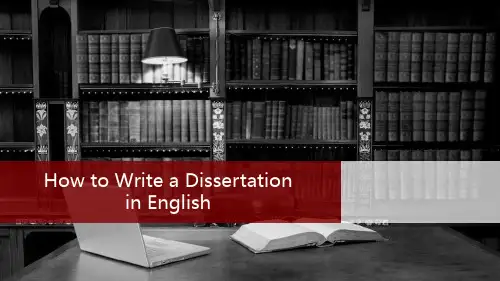
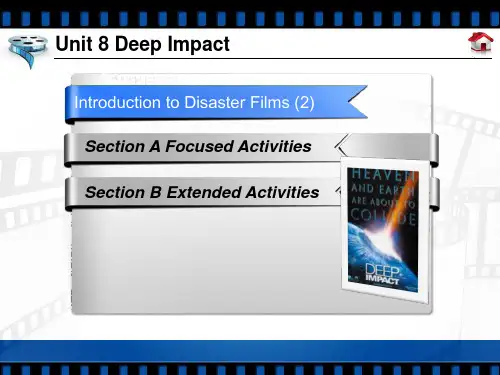
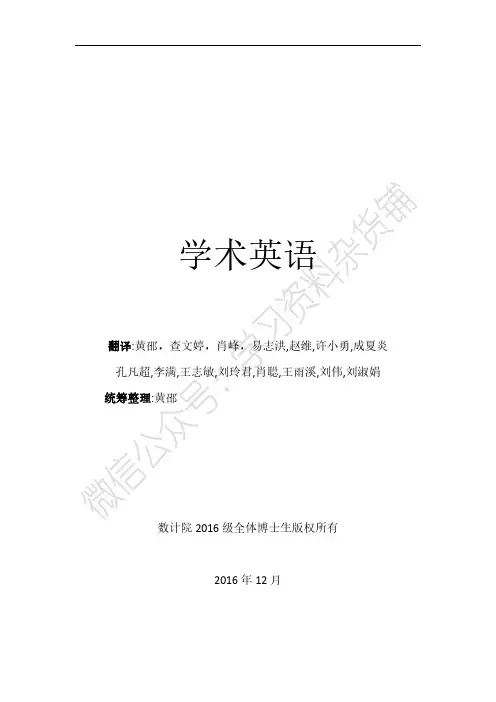
学术英语翻译:黄邵,查文婷,肖峰,易志洪,赵维,许小勇,成夏炎孔凡超,李满,王志敏,刘玲君,肖聪,王雨溪,刘伟,刘淑娟统筹整理:黄邵数计院2016级全体博士生版权所有2016年12月目录UNIT1Text A文学的范围和内容 (1)UNIT1Text B (4)UNIT3Text A (7)UNIT3Text B (10)UNIT5Text A (11)UNIT5Text B (14)UNIT8Text A (17)UNIT8Text B (20)UNIT10Text A (24)UNIT10Text B (27)UNIT1Text A文学的范围和内容文学的范围1文学是人类表达的一种形式。
但是并不是所有的用文字组织写下来的都算作文学。
那些主要提供信息的比如技术性的、教育性的、新闻业的写作虽然没有被所有的评论家但是被大部分评论家排除在文学的范畴之外。
然而,某些形式的普遍被认为作为一种艺术而属于文学。
如果本身就拥有艺术价值的话这些形式的个人划分就是成功的否则就是失败的。
相比于识别艺术价值本质它的定义更难。
作者甚至不需要追求它来实现它。
相反的,一个科学博览会可能有很大的文学价值而一首一般的打油诗却一点文学价值都没有。
2纯的文学形式是抒情诗、是伤感的、壮丽的、喜剧的、叙事的、说明的韵文。
大多数文学批判理论都是基于对诗歌的分析,因为文学的美学问题都是以最简单最纯粹的形式呈现。
作为文学失败的诗歌不能叫做诗歌只能叫做句子。
许多小说--当然所有世界上伟大的小说--都是文学,但是有成千上万的小说并不认为是文学。
大部分伟大的戏剧被认为是文学。
3希腊人把历史看成七种艺术之一,灵感来自于女神及缪斯Clio。
所有的世界历史经典调查都可以作为文学艺术的高尚例子,但是大部分现今的历史作品和研究在写作的时候并没有考虑文学上的突出,尽管偶然有文学上的优点。
4散文曾有意写为文学作品;主题退居其次。
如今的散文多为论述性的,信息性的文章新闻,尽管如此还是有很多的散文作家传统地把自己看作艺术家。
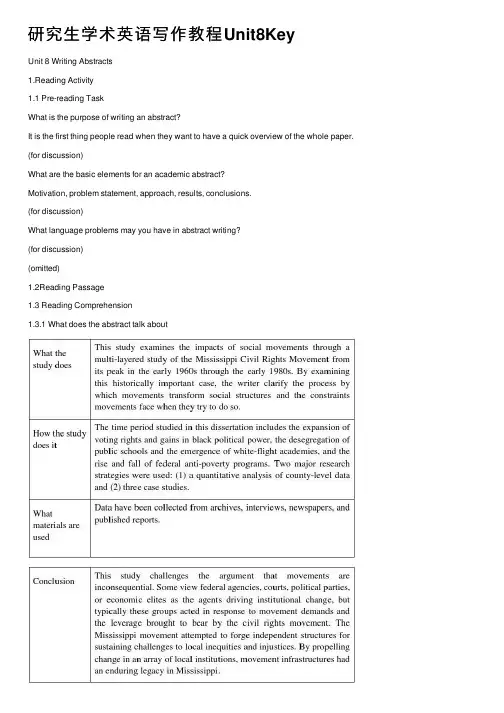
研究⽣学术英语写作教程Unit8KeyUnit 8 Writing Abstracts1.Reading Activity1.1 Pre-reading TaskWhat is the purpose of writing an abstract?It is the first thing people read when they want to have a quick overview of the whole paper. (for discussion)What are the basic elements for an academic abstract?Motivation, problem statement, approach, results, conclusions.(for discussion)What language problems may you have in abstract writing?(for discussion)(omitted)1.2Reading Passage1.3 Reading Comprehension1.3.1 What does the abstract talk about1.3.2Decide how many elements this sample includes and how they function.2Language Focus2.1 Commonly used verbs in abstracts; tenses in abstracts2.22.2 Verb tenses in abstracts3Writing Practice3.1A review of groundwater remediation in use today shows that new techniques required solve the problems of pump and treat, containment and in-situ treatment.3.2The use of a funnel and gate system via a trench has been examined in detail3.3The modeling involved an analysis of the effect of changing the lengths of the walls and gate, varying the permeability, and varying the number of gates.3.4An important factor in designing the walls is the residence time of the water in the gate or the contact time of the contaminant with the reactive media.3.5The results of the modeling and sensitivity analysis are presented such that they can be used as an aid to the design of permeable treatment walls.3.23.3Writing keywords4. Writing project4.1 Get prepared for writing an abstract 4.2 Outlining an abstract4.3Abstract:“Megacities” are defined as urban areas with more than ten million inhabitants. By 2015 it is estimated that Asia (where muchof the worldwide process of urbanization is taking place) may contain as many as 60 Megacities housing more than 600 million people in total. This number will dramatically increase over the next decades with more than 2 billion people living in Megacities by the end of this century. Low carbon performance is a fundamental aspect of the sustainable planning of a new urban development. Sustainable master planning has four components, namely operating energy use, embodied energy associated with buildings, energy supply infrastructures, other infrastructures such as transport, waste, water, sewage, etc. These aspects need to be understood to inform the concept design at its earliest stage, especially if designed to cater for the needs of global megacities where ramifications of poorly integrated planning could result in profound and long-lasting impacts on carbon and energy intensity. This paper describes how these aspects of low carbon planning and design can be assessed by using urban scale modeling, namely the Energy and Environmental Prediction model (EEP-Urban), at a whole city and building plot level. Keywords:Urban planning, High density, Urbanization, Energy modeling, Low carbon。
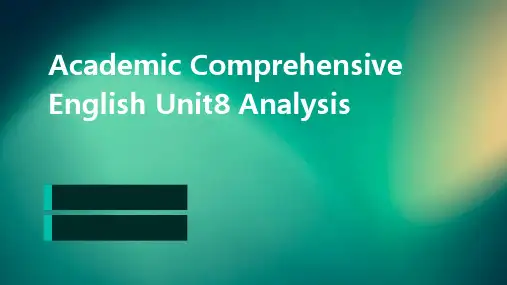
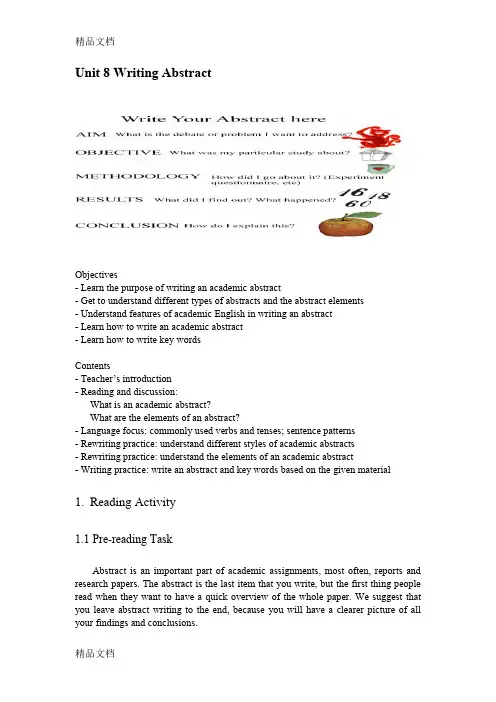
Unit 8 Writing AbstractObjectives- Learn the purpose of writing an academic abstract- Get to understand different types of abstracts and the abstract elements- Understand features of academic English in writing an abstract- Learn how to write an academic abstract- Learn how to write key wordsContents- Teacher’s introduction- Reading and discussion:What is an academic abstract?What are the elements of an abstract?- Language focus: commonly used verbs and tenses; sentence patterns- Rewriting practice: understand different styles of academic abstracts- Rewriting practice: understand the elements of an academic abstract- Writing practice: write an abstract and key words based on the given material1.Reading Activity1.1 Pre-reading TaskAbstract is an important part of academic assignments, most often, reports and research papers. The abstract is the last item that you write, but the first thing people read when they want to have a quick overview of the whole paper. We suggest that you leave abstract writing to the end, because you will have a clearer picture of all your findings and conclusions.Before you learn the detailed steps to write an abstract, please discuss the following questions:What is the purpose of writing an abstract?What are the basic elements for an academic abstract?What language problems may you have in abstract writing? (For example: the wording problem, the tense problem and the voice problem, etc.)1.2Reading PassageSample Abstract 1This dissertation examines the impacts of social movements through a multi-layered study of the Mississippi Civil Rights Movement from its peak in the early 1960s through the early 1980s. By examining this historically important case, the writer clarifies the process by which movements transform social structures and the constraints when they try to do so. The time period studied includes the expansion of voting rights and gains in black political power, the desegregation of public schools and the emergence of white-flight academies, and the rise and fall of federal anti-poverty programs. Two major research strategies were used: (1) a quantitative analysis of county-level data and (2) three case studies. Data have been collected from archives, interviews, newspapers, and published reports. This dissertation challenges the argument that movements are inconsequential. Some view federal agencies, courts, political parties, or economic elites as the agents driving institutional change, but typically these groups acted in response to the leverage brought to bear by the civil rights movement. The Mississippi movement attempted to forge independent structures for sustaining challenges to local inequities and injustices. By propelling change in an array of local institutions, movement infrastructures had an enduring legacy in Mississippi.(Kenneth Tait Andrews, “‘Freedom is a constant struggle’: The dynamics and consequences of the Mississippi Civil Rights Movement, 1960-1984″ Ph.D. State University of New York at Stony Brook, 1997 DAI-A 59/02, p. 620, Aug 1998)1.3 Reading Comprehension1.3.1 What does the abstract talk about?1.3.2Decide how many elements this sample includes and how they function.2Language Focus2.1 Commonly used verbs and tenses in abstractsRead the following sample abstract and pay attention to the verbs used in it. Sample abstract 2Cybercrime –crime on the Internet –is of growing concern in the business community. Despite UK Government initiatives (such as BS7799) and growing sales in software solutions (e.g. anti-virus software), cyber attacks are on the increase. This dissertation focuses on ways to assess the effectiveness of current preventative measures to cybercrime and to understand why organizations continue to be vulnerable to cybercrime. This dissertation met these twin research aims through an extensive study of relevant literature and the implementation of practical research. The latter was carried out through a Case Study with Company XXX using semi-structured interviews with key I.T. security personnel. This research produced a number of key findings: recent surveys confirm a significant increase in the incidences of cybercrime and their impact on the business community but also the types of cybercrime (viruses, hacking, spam, identity theft, fraud, privacy issues, web vandalism, etc.); organizations lacked the security expertise to deal with cybercrime and so depended too much on readily available technical ways to combat cybercrime (and failing); organizations were not aware of Government recommendations on how to address Internet-based security issues; and Governments and law enforcement agencies tended to localize cybercrime, allocating scant resources to contributing to a global solution. The main conclusions drawn from this research were that current approaches to fighting cybercrime are deficient because they fail to embrace a holistic approach, instead opting for a narrow local software-based focus, and that a lack of communication between major stakeholders at local, national and international level has hindered security development. This research argues for a multi-pronged model to reduce incidences of cybercrime. It takes into account Risk-Assessment models, local management of company policies, implementation issues (including proper resourcing and review policies), the need for global support infrastructures, and a means of fostering communication networks.(/Dissertation_Abstract.htm)2.2 More verbs and sentences patterns2.2 Verb tenses in abstractsRead the abstract above again and check the tenses in the abstract.3Writing Practice3.1 Abstract writing practice3.1.1 Why do we care about the problem and the results? If the problem is not obviously "interesting", it might be better to put motivation first; but if your work is incremental progress on a problem that is widely recognized as important, then it is probably better to put the problem statement first to indicate which piece of the larger problem you are breaking off to work on. This section should include the importance of your work, the difficulty of the area, and the impact it might have if successful. Read the following paragraph and write down the Motivation in the blank.A review of groundwater remediation in use today shows that new techniques are required to solve the problems of pump and treat, containment and in-situ treatment. One such technique is the method that involves the use of permeable treatment walls. These methods use a reactive medium such as iron to remediate contaminated groundwater.3.1.2 What problem are you trying to solve? What is the scope of your work (a generalized approach, or for a specific situation)? Be careful not to use too much jargon. In some cases it is appropriate to put the problem statement before the motivation, but usually this only works if most readers already understand why the problem is important. Read the following paragraph and write the problem (aim) in the blank.Several methods of implementing this remediation strategy have been described. These methods include injection and trenching. The use of a funnel and gate system via a trench has been examined in detail using a groundwater modeling option of the FLAC program.3.1.3 How did you go about solving or making progress on the problem? Did you use simulation, analytic models, prototype construction, or analysis of field data for an actual product? What was the extent of your work (did you look at one application program or a hundred programs in twenty different programming languages?) What important variables did you control, ignore, or measure? Read the following paragraph and write the approach in the blank.The use of a funnel and gate system via a trench has been examined in detail using a groundwater modeling option of the FLAC program. The modeling involved an analysis of the effect of changing the lengths of the walls and gate, varying the permeability, and varying the number of gates.3.1.4 What is the answer? Specifically, most good computer architecture papers conclude that something is so many percent faster, cheaper, smaller, or otherwise better than something else. Put the result there, in numbers. Avoid vague, hand-waving results such as "very", "small", or "significant." If you must be vague, you are only given license to do so when you can talk about orders-of-magnitude improvement. There is a tension here in that you should not provide numbers that can be easily misinterpreted, but on the other hand, you do not have room for all the caveats. Read the following paragraph and write the result in the blank.The results showed that increasing the wall length, gate length and permeability increases the size of the plume captured. An important factor in designing the walls is the residence time of the water in the gate or the contact time of the contaminant with the reactive media.3.1.5 What are the implications of your answer? Is it going to change the world (unlikely), be a significant "win", be a nice hack, or simply serve as a road sign indicating that this path is a waste of time (all of the previous results are useful). Are your results general, potentially generalizable, or specific to a particular case? Read the following and write the conclusion in the blank:A sensitivity analysis has been conducted that shows that increasing the size of the capture zone decreases the residence time which will limit the design. The results of the modeling and sensitivity analysis are presented so that they can be used as an aid to the design of permeable treatment walls.3.2 The following is a structured abstract from a report examining the network legitimacy in China telecommunication market (Low, Johnston, and Wang 97). Read it and transfer it into an informative abstract.Abstract structurePurpose – The purpose of this paper is to establish the importance and approaches in securing an organization’s legitimacy from the network community of customers, suppliers and manufacturers, including private investors and state-owned institutions when marketing their products.Design/methodology/approach –The paper presents an inductive interpretative approach complemented by action-based research founded on inquiry and testing.Findings –The paper finds that the key to legitimacy success involves using legitimacy orientations to demonstrate commitment to the interests of constituents, acquiring legitimacy from them, but concurrently considering the central government’s influence on a firm’s legitimacy performance.Research limitations/implications –The multiple interactions proposed in this paper remain untested and might have to be modified pending further empirical testing and analysis.Practical implications –In China’s telecommunication market, a company’s legitimacy emanates first and foremost from the development and commercialization of innovative and creative technological solutions. This requires good, creative management of technological resource and activity links, connecting the company’s technology to network constituents which include local manufacturers, carriers, software developers, investors.Originality/value – This is the first published paper that examines the proposed interactions among legitimacy orientations, alignments, and performances from a “market-as-network” perspective in a dynamic, transitional Chinese telecommunication market.3.3Writing keywordsKeywords often stand alone after the Abstract. In choosing the key words, a wide choice of keywords increases the probability that a paper will be retrieved and read, thereby potentially improving citation counts and journal impacts. To ensure that your paper can be found and cited by as many readers as possible, as suggested by James Hartley, it might be worth considering selecting keywords from a series of categories such as Discipline (e.g. economic, chemistry, biomedical), Methods (e.g. experiment, case study, questionnaire, grounded theory), Data source (e.g. primary, secondary, tertiary students, senior citizens), Location (e.g. country, city, town, institution), Topic (e.g. air pollution, super-virus, earthquake). Such a selection of keywords allows the search engine, such as Google Advanced Scholar, to list your paper in the results no matter which of the above keywords the reader types in.The researchers sometimes have to trade-off between the keywords, particularly when they write for the journals that bound the number of keywords in the limit of 3~5. In this situation, choose the keywords from recent or often-cited titles close to your contribution. If you pick your keywords in this way, the searches that retrieve these articles will also retrieve yours. Consequently, the chances of your paper being read will increase. Read the above sample abstracts and write down the key words:4. Writing project4.1 Get prepared for writing an abstractBefore you write the Abstract section of your research paper, you need to make everything ready for your writing. The following steps may be helpful for your preparation.1) Identify the major objectives and conclusions.2) Identify phrases with keywords in the methods section.3) Identify the major results from the discussion or results section.4) Assemble the above information into a single paragraph.5) State your hypothesis or method used in the first sentence.6) Omit background information, literature review, and detailed description ofmethods.7) Remove extra words and phrases.8) Revise the paragraph so that the abstract conveys only the essential information.9) Check to see if it meets the guidelines of the targeted journal.10) Give the abstract to a colleague (preferably one who is not familiar with yourwork) and ask him/her whether it makes sense.Work in groups and discuss what other preparations you can make for writing an abstract section of your research paper.4.2 Outline an abstractWhen we outline an abstract, there are usually five major aliments to follow. The following sample paper is finished without the abstract and key words. Read the paper, find the statements concerned and fill in the blank after it.Sample paperGLOBAL MEGACITIES AND LOW CARBON: FROM CONCEPT PLANNING TO INTEGRATED MODELLINGPhil Jones, Simon Lannon, Robbert van Nouhuys, Hendrik RosenthalMega citiesIn 1950, 30% of the world’s population lived in cities. In 2000, it was 47%. By 2010 more than half of the world’s population will be living in cities. The total may even reach 60% by 2030 and possibly 85% by the middle of this century. Such rapidly increasing urbanization, particularly in developing countries, creates many opportunities and challenges.We are living in a globalized and changing world whereby increasingly we require wise use of human and natural resources. At the same time, we need to reduce the risk urbanization poses and enhance the quality of life for all those who live in, or are impacted by Megacities. Megacities are more than just large cities with populations of 10 million inhabitants or more. They are critical to national economies. Their scalecreates new dynamics, new complexity and new simultaneity of events and processes –physical, social and economic. They host highly efficient economic activities utilizing intense and complex interactions between different demographic, social, political, economic and ecological processes.Nations undergoing economic progress often generate rapid urbanization linked with considerable opportunities, as well as strong pressures for change accompanied by environmental degradation. In current times in the developing world, Megacities grow faster than ever before and much faster than their infrastructure can support. Traditionally this results in uncontrolled urban sprawl, high traffic volumes and congested transport systems, high concentrations of industrial production, ecological overload, unregulated and disparate land and property markets, insufficient housing development, excessive waste generation, loss of productivity, general economic constipation, degradation and decline.Over the past decades traditional Megacities have been suffering from inadequate representative governance, inhibiting spatial planning, building control, delivery of services (such as water supply, sewage disposal and energy distribution), and the establishment of general order (including security and disaster prevention). Existing administrations and their organizational structures may have been outgrown by the rapidly expanding city and may simply be unable to cope with the huge scale of their new responsibilities. On the other hand, megacities contain a rich mix of coexisting people and support systems when properly planned and managed. Groups with their own distinctive ethnic, community, cultural roots, lifestyles and social surroundings have opportunity to thrive and develop. Differences in economic development, social polarization, quality of infrastructure and governance are recognized and taken into account. The scale and dynamism of Megacities, coupled with complex interacting processes and the sheer concentration of human capital make them incubators of huge growth and innovation. Megacities are the focal points of globalization as well as the driving forces for development; they harbor a wide spectrum of human skill and potential, creativity, social interaction and cultural diversity.For Hanoi to develop within a rapid urbanization scenario it must look far ahead –not 20 years, not 50 years but 100 years –into the 22nd Century. The use of conventional planning and economic development guidelines have proven to be outdated, resulting in the risk of harboring pronounced poverty, social inequality, and aggravating rapid environmental degradation. Population density, if not managed, increases vulnerability to natural and man-made hazards. Thus, Megacities are both victims and producers of risk, if unmanaged and exposed to the global environmental, socio-economic and political changes to which they contribute.Megacities will be essential and efficient drivers of a nation’s gross domestic product, processes and activities. Megacities will be ideal places to drive activities and innovation to solve social, environmental, medical, socio-economic and political issues. For these reasons, Megacities are necessary and have potential to substantially contribute towards global justice and peace – and thereby prosperity.Low Carbon and Energy ModelingAspects of sustainable master planning that impact carbon and energy implications need to be understood to help inform concepts at the earliest stage of the design process. For example, the full benefits of reducing operating energy demand of buildings can only be realized if the energy supply can respond to the reduced demand, which includes the additional benefits of reducing the energy supply infrastructure, which in turn reduces its embodied energy. Likewise, if a low (or zero) carbon energy supply is to be used, for example, renewable energy, this is easier to achieve if first the energy demand is reduced. Also, as the operating energy performance of buildings is improved the carbon dioxide emissions associated with the operation of the building, for heating, cooling, lighting, etc., becomes of the same order as the embodied energy used in construction and fit-out of the building and its infra-structure. So a balanced approach across energy demand and supply infrastructure, operating energy and embodied energy, is needed to achieve optimum performance.This paper describes how the aspects of low carbon planning and design (i.e. operating energy use, embodied energy associated with buildings, energy supply infrastructures, and other infrastructures such as transport, waste, water, sewage, etc.) can be assessed using urban scale modeling, namely EEP-Urban, at a whole city and building plot level. In particular, it explores how the reduction in energy supply infrastructure together with reduced energy demand can lead to reductions in carbon dioxide emissions associated with both operating and embodied energy. The concept of the Megacity in the context of Hanoi in 2110 is used to illustrate the model.The Concept of Metabolic Super ClustersHanoi in 2110 will feature super tall skyscrapers, elevated connectors and railways, nodal communication networks, as well as electrical and energy corridors. Vertical neighborhoods, where people live, shop, relax and work, are built on and above this surface. Built structures are not just individual towers standing independent from another but instead are interlinked and inter-dependent to form an urban spatial organization that allows for vertical connectivity.The urban model proposes 1 million people on a 1 square kilometer floor plate, hence called a Super Cluster. Under current suburban density standards a similar population would require in the order of 100 square kilometers. Thus, this vision for Hanoi in 2110 saves 99% of land for other uses, most notably conservation of ecological functions and provides food, leisure, material and energy support systems for the city thereby localizing the ecological footprint of the city.Another distinct aspect of Hanoi in 2110 is that it does not have static building functions. Instead, land use layers, building envelopes and orientations change over time – hourly, daily, weekly, monthly, yearly – to optimize performance efficiencies, therefore becoming a Metabolic Super Cluster. It is envisaged that Hanoi by the end of this century will consist of 30 metabolic super clusters in addition to its traditional urban city centre.Concentrated compact development will enhance the quality of life for urban dwellers because all infrastructures, environmentally damaging and other undesirablesurface activities are located underground or integrated into the vertical structure, thereby significantly improving the quality of living space at the ground, open-air level. Underground space may also provide a safer environment for some public and commercial activities as well as providing shelter from inclement weather conditions. This may prove to be essential for infrastructure in particular, given the predicted impacts associated with climate change. Elevated multi-level connectors between building clusters are converted into common corridors with public amenities, farms and open space.Quality of life depends on individual perceptions, attitudes, aspirations and value systems. These differ with age, ethnicity, culture and religion, as well as lifestyles, education and cultural background. An individual’s priorities and attitudes to life depend heavily upon socio-economic background and cultural environment. Historic places, cultural sites or public spaces may give Megacities a certain unique identity, heritage, and authenticity. As a result, such spatial capital contributes to social cohesion and makes people feel at home.Nevertheless, the general opinion may be that the quality of life for many residents in Megacities would be low – for rich and poor alike. Air, water and soil pollution, water and energy supply shortages, traffic congestion, environmental health problems, limited green spaces, poverty and malnutrition, social security and public safety problems place many burdens and restrictions on people.The Megacity of the future has adapted to greater diversity in socio-cultural circumstances by including and enhancing the often widespread and dynamic informal activities that enrich such communities. Further development of new visions and innovative management tools are now urgently needed in order to enhance quality of life and create cohesive communities.Urban governance and management is one of the key success factors of any global Megacity. As society and aspirations evolve over time, the city has to be designed to adapt to change. Utopian cities built around fixed ideologies have never worked. Megacities need to be versatile in order to adapt.The main challenges for a Megacity in terms of urban governance are: dealing with the speed of change with intelligent urban infrastructure systems; eradicating social exclusion; and introducing proper forms of urban governance.Way ForwardWhether or not 1 million people are appropriate for a 1 km2 super cluster remains to be seen. The optimum density for sustainability, land use and quality of life may be less and will vary with global location. The above approach is essential to inform the design of high rise high density Megacities if they are to realize their full potential for providing sustainable healthy zero carbon cities of the future that can co-exist in a sustainable way with their neighboring rural areas.4.3 According to the above table, draft an abstract and keywords for the sample paper. Abstract:Key words:5.Final Checklistbackground, purpose, findings, conclusions, recommendations and follow strictly the chronology of the report/papers.∙Avoid excessive use of jargon, and exaggerative language∙Keep within the specified word limit. Most institutions will have their own "house rules" as to the length of the abstract. The abstract should stand alone and be able to be understood without reference to citations,∙Ensure the abstract contains all your key words (for the searchable databases). ∙Add no new information but simply summarize the report/papers. Be intelligible to a wide audience。
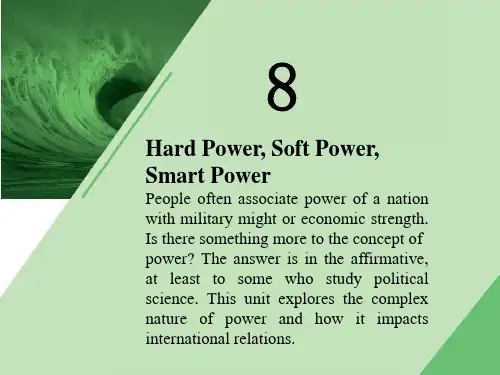
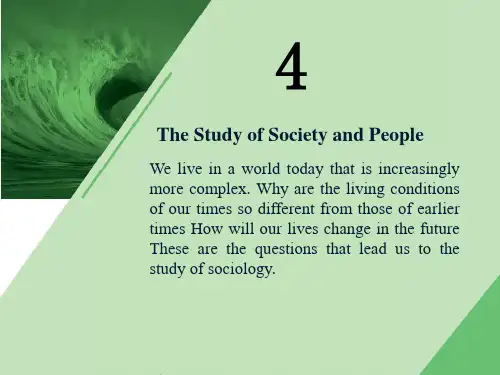
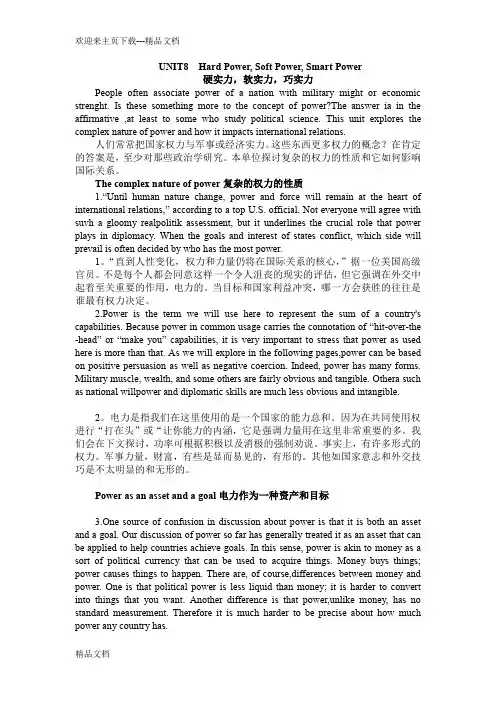
UNIT8 Hard Power, Soft Power, Smart Power硬实力,软实力,巧实力People often associate power of a nation with military might or economic strenght. Is these something more to the concept of power?The answer ia in the affirmative ,at least to some who study political science. This unit explores the complex nature of power and how it impacts international relations.人们常常把国家权力与军事或经济实力。
这些东西更多权力的概念?在肯定的答案是,至少对那些政治学研究。
本单位探讨复杂的权力的性质和它如何影响国际关系。
The complex nature of power复杂的权力的性质1.“Until human nature change, power and force will remain at the heart of international relations,” according to a top U.S. official. Not everyone will agree with suvh a gloomy realpolitik assessment, but it underlines the crucial role that power plays in diplomacy. When the goals and interest of states conflict, which side will prevail is often decided by who has the most power.1。
人文英语1unit8参考答案人文英语1 Unit 8 参考答案Unit 8: Cultural HeritageSection A: Vocabulary and Grammar1. Multiple Choice Questions- (1) The correct answer is C. "Preservation" as it refers to the act of keeping something in its original state.- (2) The answer is B. "Cultural heritage" is the term used to describe the legacy of physical artifacts and intangible attributes of a group or society that areinherited from past generations, maintained in the present, and bestowed for the benefit of future generations.- (3) The correct answer is A. "Destruction" is the act of causing something to be demolished or ruined.2. Fill in the Blanks- (1) The ancient city has been well preserved for centuries.- (2) The cultural heritage of the region is rich and diverse.- (3) The war led to the destruction of many historical sites.3. Error Correction- (1) The sentence should read: "The preservation ofcultural heritage is crucial for maintaining our identity." - (2) The corrected sentence is: "The destruction of historical monuments is a great loss to humanity."- (3) The error should be corrected to: "The cultural heritage site was restored to its original state."Section B: Reading Comprehension1. True or False Questions- (1) True. The article states that cultural heritage is an important part of our identity.- (2) False. The article mentions that cultural heritageis not only about physical artifacts but also includes intangible aspects.- (3) True. The article discusses the importance of preserving cultural heritage for future generations.2. Comprehension Questions- (1) The main idea of the passage is the significance of preserving cultural heritage and the various forms it can take.- (2) The passage mentions that cultural heritage includes both tangible and intangible elements.- (3) The article suggests that the preservation of cultural heritage is essential for maintaining a connection with the past and for the identity of a society.Section C: Writing Task1. Sample EssayThe preservation of cultural heritage is a critical aspectof our society. It serves as a bridge connecting the past, present, and future. Cultural heritage encompasses a wide range of elements, from historical buildings and artifacts to traditional practices and languages. It is our responsibility to protect and maintain these treasures for the benefit of future generations.To begin with, cultural heritage provides a sense of continuity and identity. It helps individuals understandtheir roots and the evolution of their society. Furthermore, it fosters a sense of pride and belonging among the members of a community.Additionally, cultural heritage is a valuable resource for education and research. It offers insights into the history, art, and social structures of different periods. This knowledge can be used to inform current practices and inspire new ideas.However, cultural heritage is under constant threat from various factors such as urban development, natural disasters, and even political conflicts. It is crucial that we take proactive measures to safeguard these invaluable resources. This can be achieved through legal protections, public awareness campaigns, and international cooperation.In conclusion, the preservation of cultural heritage is not just a matter of sentimentality; it is a vital component of our collective memory and identity. By taking steps to protect and cherish our cultural heritage, we ensure that future generations can continue to learn from and appreciatethe rich tapestry of human history.Section D: Discussion Questions1. Discuss the importance of preserving cultural heritage and how it can contribute to a society's identity.2. What are some of the challenges faced in preservingcultural heritage, and how can they be addressed?3. How can technology be used to assist in the preservation and promotion of cultural heritage?This set of answers provides a comprehensive review of Unit 8, covering vocabulary, grammar, reading comprehension, writing, and discussion topics related to cultural heritage.。
学术英语视听说u n i t8原文T i d a lw a v e s精品资料Today, our lecture is about tidal waves. I’ll define what a tidal wave is and what a tidal wave is not. I’ll also define some other terms related to tidal waves. So, what is a tidal wave?A tidal wave is a very large and very destructive wall of water. This wall of water rushes in from the ocean toward the land. Scientists use the Japanese word ”tsunami”to describe this waves. In Japanese, tsunami actually means harbor wave, you see the waves are tallest when they reach a harbor which is an area of the ocean just before the land where boats are kept. Now, normal waves are caused by tides or storms over the water. But did you know that tidal waves are not caused by storms and that tidal waves are not really tides at all? A true tide can be defined as the regular rise and fall of ocean waters at definite times each day. A tidal wave or tsunami comes rushing in suddenly and unexpectedly at any time. It could come rushing in during the morning, in the afternoon or during the night. A tidal wave is caused by an underwater earthquake, to quake means to move up and down or from side to side very quickly, to quake also means to shake or to tremble, when an earthquake takes place under the ocean, the ocean floor shakes and trembles, and sometimes the ocean floor shifts. That is the ocean floor moves. It is the shifting of the ocean floor that produces the tidal wave. The earth and water move, causing a tidal wave. The tidal wave begin to move across the sea at great speed. In 2011, a massive earthquake occurred of the coast of Japan, the quake caused a double wave tsunami. A double wave tsunami can also be called a merging tsunami. When a merging tsunami or double-wave tsunami occurs, two very large waves combined. This increases the destruction when the tidal wave reaches land. Tsunamis have taken many lives in the past, for instance, the tsunami caused by a 9.0 magnitude earthquake off the coast of Japan on March 11,2011, took the lives of more than 20 thousand people. The tsunami also destroyed large areas of northeastern Japan.Today, scientists can predict that a tidal wave will hit land, these scientists use a seismograph, a seismograph is a type of instrument that recalls the strength, direction and length of an earthquake. The seismograph tells the scientists if the earthquake under the ocean is likely to cause a tidal wave. So although it is not possible to stop a tidal wave, it's possible to warn people that a tidal wave is coming. This warning can save many lifes.仅供学习与交流,如有侵权请联系网站删除谢谢2。
UNIT8 Hard Power, Soft Power, Smart Power硬实力,软实力,巧实力People often associate power of a nation with military might or economic strenght. Is these something more to the concept of power?The answer ia in the affirmative ,at least to some who study political science. This unit explores the complex nature of power and how it impacts international relations.人们常常把国家权力与军事或经济实力。
这些东西更多权力的概念?在肯定的答案是,至少对那些政治学研究。
本单位探讨复杂的权力的性质和它如何影响国际关系。
The complex nature of power复杂的权力的性质1.“Until human nature change, power and force will remain at the heart of international relations,” according to a top U.S. official. Not everyone will agree with suvh a gloomy realpolitik assessment, but it underlines the crucial role that power plays in diplomacy. When the goals and interest of states conflict, which side will prevail is often decided by who has the most power.1。
外研社版学术英语综合U n i t8译文-CAL-FENGHAI.-(YICAI)-Company One1第八单元全球化Text A从柏柏尔人到巴赫的全球化之路马友友作为职业大提琴手已有三十余年,其间有整整二十个年头都一直奔波在巡演的路上,与此同时,我也致力于了解各种音乐的传统与文化。
正是这些旅途让我认识到文化传统在全球化的世界中所扮演的角色——为个体身份、社会安定与友好交流建立至关重要的框架。
当今世界变化日新月异,这必然会导致文化上的不稳定,人们也不禁对自身的定位产生疑问。
在全球化背景下,我们不得不屈从于他人的规则,因此常常会威胁到个体的特性。
这种处境令我们不安,因为屈从他人规则就意味着不得不改变我们坚守数千年并引以为傲的风俗习惯。
因此,当前全球化背景下的领导者们所面临的一个关键问题就是:如何才能在不牺牲个体特性与文化自豪感的同时,让各种文化和习俗逐渐发展到能够适应一个更大的平台呢这些年的音乐之旅告诉我,全球化进程中的交流互动并不只会破坏文化,相反,它不仅能创造新的文化,而且还会为那些存在了几世纪的古老传统注入新的活力,使其被世界上更多的人熟知。
这一点与生态学上的群落“边缘效应”类似,后者本身是用来描述两个不同的生态系统交汇时的景象。
例如,在森林与大草原这两种生态系统的交界之处,存在着密度最小但种类最多的生命形态,而每一种形态都汲取了两种生态系统的精髓。
由此可见,有时候最有趣的事情往往发生在边缘地带,而交叉地带往往能够揭示出意想不到的联系。
文化,就像是聚集了世界各地瑰宝的拼图。
探索世界的途径之一正是深入地挖掘文化传统的核心。
举一个音乐领域的例子,每一位大提琴手的核心曲目都是巴赫的《无伴奏大提琴组曲》。
而每一个组曲的核心都是一种叫做萨拉班德舞(sarabande)的舞曲。
这种缓慢而感性的舞曲最早来自于北非柏柏尔人的音乐,随后流传到西班牙,但因当时人们认为曲子猥亵而遭到禁止。
后来西班牙人将这种舞曲又带到美洲,继而流传到了法国,在那里演化为一种庄严的宫廷舞蹈。